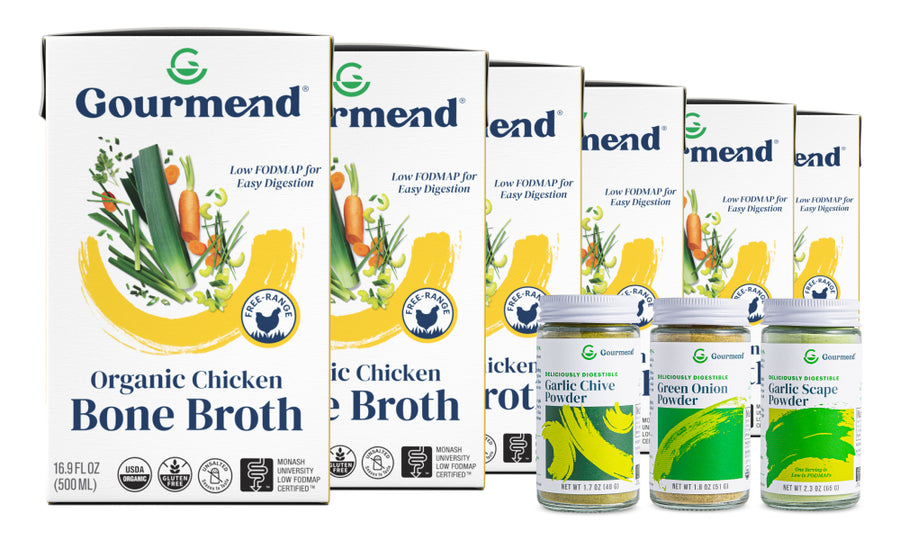Chicken Stock vs Broth: Master These Essential Basics

Chicken Stock vs Broth: What's the Real Difference?
Ever stood in your kitchen wondering whether you should reach for chicken stock or broth? You're not alone. Despite being staples in kitchens worldwide, the difference between stock and broth remains one of cooking's most common confusions. The fundamental distinction comes down to ingredients, preparation method, and ultimately, how they function in your recipes.
In the simplest terms: stock is made primarily from bones simmered for extended periods, creating a rich, gelatinous base, while broth is made from meat, resulting in a lighter, more directly flavorful liquid. This distinction affects everything from texture to culinary applications—and knowing the difference can transform your cooking.
Understanding Stock vs Broth: The Fundamental Differences

When I first started cooking seriously, I used stock and broth interchangeably, assuming they were just different names for the same thing. It wasn't until I worked alongside professional chefs that I realized how distinct these two foundational ingredients actually are—and how differently they behave in recipes.
What Makes Chicken Stock Special?
Chicken stock is essentially liquid gold in culinary circles, prized for its body and depth. Here's what defines a true stock:
- Made primarily from chicken bones with little to no meat attached
- Contains aromatic vegetables like onion, carrots, and celery (the classic mirepoix).
- Includes herbs such as bay leaves, thyme, and parsley stems
- Simmered slowly for 4-6 hours (or longer) to extract collagen from bones
- Minimal seasoning—typically unsalted or very lightly salted
- Becomes gelatinous when chilled due to collagen breakdown
Here at Gourmend, we swap out onion for ingredients like scallion tops, leek tops and chives to keep the final broth Low FODMAP and much easier on digestion. This way, we retain the classic flavors of mirepoix while enhances nutritional value and flavor.
The magic of stock happens during that long, slow simmer. As the collagen in chicken bones breaks down, it transforms into gelatin, giving stock its distinctive body and silky mouthfeel. This is why properly made stock jiggles when refrigerated—a sign of quality that chefs look for.
What Defines Chicken Broth?
Chicken broth takes a different approach, focusing on meat rather than bones:
- Made primarily from chicken meat—often whole chicken pieces or a whole bird
- Includes similar aromatics as stock (mirepoix and herbs)
- Simmered for a shorter time, typically 1-2 hours
- Usually seasoned with salt and sometimes other spices
- Remains liquid when chilled due to lower gelatin content
- Has a clearer, lighter appearance with direct chicken flavor
Broth extracts the flavor compounds from meat rather than the structural proteins from bones. This creates a lighter liquid with a more straightforward chicken taste that can stand on its own—which is why you can sip broth by itself but would rarely do the same with stock.
The Science Behind Stock and Broth
The differences between stock and broth aren't just culinary tradition—they're rooted in food science that affects how each performs in cooking.
Why Stock Gets Gelatinous
The defining characteristic of stock—its ability to gel when chilled—comes from a specific chemical process. During long simmering, the collagen in chicken bones (primarily found in joints, cartilage, and connective tissue) breaks down into gelatin through a process called hydrolysis.
This gelatin gives stock its body and creates what chefs call "mouthfeel"—that rich, satisfying texture that coats your tongue. When you reduce stock, this gelatin becomes more concentrated, which is why reduced stock makes such excellent sauces with natural thickness and glossy appearance.
Why Broth Stays Clear and Light
Chicken meat contains much less collagen than bones, which is why broth typically doesn't gel. Instead, the relatively brief cooking time extracts water-soluble proteins, vitamins, and flavor compounds from the meat. These components create broth's characteristic clear appearance and direct chicken flavor.
The protein content in broth comes primarily from the meat itself rather than from converted collagen. This makes broth higher in protein per serving but lower in the specific amino acids found in gelatin.
Culinary Applications: When to Use Each

Understanding the structural differences between stock and broth helps you choose the right one for specific cooking applications.
Best Uses for Chicken Stock
Stock's rich body and neutral seasoning make it ideal for:
- Sauces and gravies - The natural gelatin provides body and thickening power
- Risottos and grain dishes - Adds richness without overwhelming the main ingredients
- Braising meats - Creates silky, rich braising liquids
- Hearty soups and stews - Provides depth and satisfying mouthfeel
- Reductions - Can be reduced without becoming overly salty
The lack of pre-seasoning in traditional stock gives you complete control over the salt level in your final dish. This is particularly important when reducing liquids, as salt becomes more concentrated during reduction.
Best Uses for Chicken Broth
Broth's lighter body and seasoned profile make it perfect for:
- Sipping on its own - Especially when you're feeling under the weather
- Light soups - Where clarity and clean flavor are desired
- Cooking grains - Adds flavor without heaviness
- Quick weeknight cooking - Ready-to-use flavor without additional seasoning
- Poaching delicate proteins - Adds flavor without overwhelming
Since broth is typically already seasoned, it provides immediate flavor without additional work, making it convenient for quick cooking.
Homemade vs. Store-Bought: What You Need to Know
The classical definitions of stock and broth become somewhat blurred when we look at commercial products.
The Commercial Reality
Many products labeled as "stock" in grocery stores don't actually contain the gelatin content of true culinary stock. Likewise, some "broths" might have added gelatin or concentrates to mimic stock-like properties. This inconsistency can make it challenging to know exactly what you're getting.
When examining store-bought options, it's helpful to look beyond the label to the ingredients list and nutrition facts. A true stock-equivalent should have higher protein content and might list collagen or gelatin among its ingredients.
For more detailed insights, see this Serious Eats article and Healthline's comparison.
The Bone Broth Distinction
Adding to the confusion is bone broth—a relatively recent term in commercial products that actually describes something closer to traditional stock than conventional broth. Bone broth is simmered for extended periods (often 24+ hours) to extract maximum nutrients and gelatin from bones.
At Gourmend Foods, our chicken and beef "broths" are actually bone broths, simmered low and slow to extract all those beneficial nutrients and create a rich, flavorful base for your cooking. We use the green parts of leeks, scallions, and chives instead of onion bulbs, plus oyster mushrooms for natural umami—making our products not just delicious but also low FODMAP and gut-friendly.
Making Your Own: The Gold Standard
Creating homemade stock and broth gives you complete control over ingredients and quality. For those with digestive sensitivities, homemade versions allow you to avoid common triggers like onion and garlic bulbs by substituting with low FODMAP alternatives like chives and the green parts of scallions.
When making stock at home, save chicken bones from roasted chickens in your freezer until you have enough for a batch. For broth, chicken thighs offer more flavor than breast meat, though either works well.
The Texture and Flavor Spectrum: From Light Broth to Rich Stock

The difference between chicken stock and broth isn't just academic—it creates distinct experiences in your cooking and on your palate. Think of these ingredients as existing on a spectrum of body and flavor intensity, with each serving a specific purpose in your culinary toolkit.
The Mouthfeel Factor: Why Texture Matters
When you reduce a proper chicken stock, something magical happens—it coats the back of a spoon with a silky richness that signals quality. This is the gelatin at work, creating what chefs call "body" or "mouthfeel." This characteristic makes stock irreplaceable in certain applications.
"A good chicken stock should have enough body that when reduced, it naturally thickens sauces without added starch," explains Chef Marco Pierre White, who famously called stock "the foundation of good cooking."
Broth, by contrast, remains relatively thin even when reduced. Its lighter body allows the flavors of other ingredients to shine through without the weight of stock's richness—perfect when you want to add flavor without changing a dish's texture.
Flavor Profiles: Depth vs. Directness
The flavor difference between stock and broth is subtle but significant. Stock offers complex, layered flavor with savory depth but less pronounced "chicken-ness." This subtlety allows it to enhance dishes without overwhelming them—like a supporting actor that makes the star shine brighter.
Broth delivers a more direct, immediate chicken flavor. It's like the difference between a complex symphony (stock) and a beautiful solo performance (broth)—both valuable, but serving different purposes in your cooking.
Nutritional Considerations: Stock vs Broth
Beyond culinary applications, stock and broth offer different nutritional profiles that might influence your choice depending on your health goals.
The Collagen Connection
Stock's high gelatin content comes from collagen, which breaks down during cooking into various amino acids—primarily glycine, proline, and hydroxyproline. These amino acids support joint health, gut function, and skin elasticity, making stock particularly valuable from a nutritional perspective.
Research suggests that these amino acids may help reduce inflammation and support digestive health—particularly beneficial for those with sensitive stomachs or IBS. The long simmering time also extracts minerals from the bones, including calcium, magnesium, and phosphorus.
Protein and Vitamin Content
Broth typically contains more direct protein from the meat itself rather than from collagen breakdown. It also tends to retain more water-soluble B vitamins from the meat. However, it generally offers less of the specific amino acids found in gelatin.
From a sodium perspective, commercial broths often contain more salt than stocks, though this varies widely between brands and recipes. For those monitoring sodium intake, unseasoned stock provides more control over the final salt content of your dishes.
Bone Broth: The Best of Both Worlds
beef broth the same" src="https://cdn.shopify.com/s/files/1/0255/1247/6771/t/12/assets/1748501613400-are-beef-stock-and-beef-broth-the-same.webp?v=1748501614" style="width: auto; height: 500px;">
While we've been discussing the classical definitions of stock and broth, it's worth exploring bone broth in greater detail, as it combines elements of both traditional preparations while offering unique benefits.
What Makes Bone Broth Special
Bone broth is essentially a hybrid that combines the long cooking time and bone-focused approach of stock with the seasoning and sippability of broth. It's typically simmered for 12-24 hours or even longer, allowing maximum extraction of nutrients, minerals, and collagen from the bones.
This extended cooking process creates a liquid that's rich in gelatin like stock but often seasoned to be enjoyable on its own like broth. The result is a versatile ingredient that works beautifully in recipes while also standing alone as a nourishing beverage.
The Gut Health Connection
Bone broth has gained popularity largely due to its potential digestive benefits. The gelatin in bone broth may help protect and heal the lining of the digestive tract, which is particularly relevant for those with sensitive digestion or IBS symptoms.
At Gourmend Foods, we've created bone broths specifically with gut health in mind. Our broths are not only rich in beneficial gelatin but also free from common digestive triggers like onion and garlic bulbs. Instead, we use the green parts of leeks and scallions plus chives to create flavor without the digestive discomfort.
Making Substitutions: Can You Swap Stock and Broth?
In the real world of cooking, you might not always have the ideal ingredient on hand. Understanding how stock and broth differ helps you make smart substitutions when necessary.
Using Broth When a Recipe Calls for Stock
When substituting broth for stock, you're trading richness and body for a cleaner, more direct flavor. This works well in many applications but may require some adjustments:
- For sauces and gravies, you might need to add a thickening agent like a roux or cornstarch
- Consider reducing the broth slightly to concentrate flavors
- If the broth is pre-seasoned, adjust additional salt in your recipe accordingly
- For risottos and similar dishes, the final texture might be slightly less creamy
Using Stock When a Recipe Calls for Broth
When using stock instead of broth, you're adding richness that might not have been intended in the original recipe:
- You may need to add more seasoning since stock is typically less salted
- Consider diluting very rich stock slightly with water for lighter applications
- The additional body might change the texture of delicate soups or poaching liquids
- For drinking purposes, stock will need additional seasoning to be enjoyable on its own
Beyond Chicken: Beef and Vegetable Variations

The principles that distinguish chicken stock from broth apply similarly to beef and vegetable variations, though with some important nuances.
Beef Stock vs Beef Broth: Key Differences
Beef stock is traditionally made with beef bones, often roasted first to develop deeper flavor. The roasting step caramelizes proteins and sugars in the bones, creating rich, complex flavor compounds that give beef stock its distinctive depth.
Beef broth, made primarily from meat, offers a more straightforward beef flavor. The distinction between beef stock and broth is often more pronounced than with chicken versions due to the stronger flavor of beef bones and the importance of that initial roasting step.
At Gourmend, our beef bone broth combines the best of both worlds—the rich depth from long-simmered bones with careful seasoning that makes it enjoyable on its own or as a recipe ingredient. We enhance the natural umami with nori seaweed and oyster mushrooms rather than relying on onions or MSG-laden flavor enhancers.
Vegetable Stock vs Vegetable Broth
With vegetable preparations, the distinction becomes more subtle since there are no bones or meat involved. Generally, vegetable stock tends to include more aromatic vegetables and herbs simmered for longer periods, while vegetable broth might focus on specific vegetables for their flavor profiles and color.
Without animal products to provide gelatin, vegetable stock naturally lacks the body of meat-based stocks. Some chefs add ingredients like mushrooms (particularly dried varieties) to add umami depth to vegetable stock, mimicking some qualities of meat-based preparations.
Our vegetable broth at Gourmend follows this principle, using oyster mushrooms and nori seaweed to create rich umami flavor without animal products. The result is a versatile base that works beautifully in vegetarian and vegan cooking while remaining gentle on sensitive digestive systems.
Quality Indicators: How to Spot the Good Stuff
Whether you're making your own or purchasing prepared options, knowing what indicates quality helps you make better choices.
Visual and Texture Cues
For stock, the gold standard is the "jiggle test"—when chilled, quality stock should set up like loose gelatin. This indicates proper collagen extraction. The color should be rich but clear, not cloudy or greasy.
Quality broth should have a clean, clear appearance with visible flavor oils on the surface. It should taste distinctly of chicken (or beef/vegetables) without overwhelming saltiness or artificial notes.
Ingredient Red Flags
When examining commercial options, watch for these ingredients that suggest lower quality:
- "Natural flavors" or "flavor enhancers" (often code for MSG derivatives)
- Excessive sodium levels (some commercial broths contain nearly 50% of your daily sodium in one cup)
- Corn syrup or other sweeteners (used to mask lack of natural flavor)
- Gums and stabilizers (used to create artificial body in place of natural gelatin)
- Caramel color (used to create the appearance of richness)
High-quality prepared options like Gourmend's bone broths skip these shortcuts, relying instead on traditional methods and clean ingredients to create authentic flavor and texture. Our products are certified organic and low FODMAP, making them suitable for even the most sensitive digestive systems.
The Convenience Factor
While homemade stock and broth offer the ultimate in quality control, the reality is that most home cooks rely on prepared options at least some of the time. The key is finding products that maintain the culinary integrity of traditional preparations while offering modern convenience.
Look for shelf-stable options in glass or aseptic packaging that maintain quality without refrigeration until opened. This allows you to keep these versatile ingredients on hand without taking up valuable fridge space, ensuring you're always ready to create flavorful meals at a moment's notice.
Making the Most of Your Broth and Stock

Now that we've explored the fundamental differences between chicken stock and broth, let's look at how to maximize these ingredients in your everyday cooking. Understanding when and how to use each can elevate your dishes from good to exceptional.
Storage and Shelf Life Considerations
Proper storage is crucial for maintaining the quality of both homemade and store-bought products. Homemade stock and broth can be refrigerated for 3-4 days, but for longer storage, freezing is your best option. Pour cooled stock or broth into ice cube trays or freezer-safe containers, leaving some headspace for expansion.
For maximum convenience, consider freezing in various portion sizes—ice cube trays for small amounts needed in sauces, and 1-2 cup containers for soups and larger recipes. Properly frozen, they'll maintain quality for up to 6 months.
High-quality shelf-stable options like Gourmend's bone broths offer the convenience of pantry storage until opened, making them perfect for those moments when you haven't planned ahead but still want exceptional flavor.
Enhancing Store-Bought Products
Even the best commercial products sometimes benefit from a little enhancement. To elevate store-bought stock or broth:
- Simmer with fresh herbs like thyme, rosemary, or bay leaves for 15-20 minutes
- Add aromatic vegetables like leek tops, scallion greens, or chives for deeper flavor without digestive triggers
- Include a splash of white wine or a squeeze of lemon for brightness
- For more umami, add a small piece of kombu seaweed or a few dried mushrooms
- Reduce by 25% to concentrate flavors for more impactful sauces
These simple additions can transform even basic broths into something that tastes homemade, without the hours of simmering time.
Chicken Stock vs Broth: Which is Better for Specific Dishes?
The choice between stock and broth isn't about which is better overall, but rather which is better suited to specific applications. Here's a quick reference guide for common dishes:
Best Uses for Stock
- Risotto and Rice Dishes: The gelatin in stock creates the creamy texture that defines great risotto without adding dairy
- Pan Sauces: Stock reduces beautifully, coating the back of a spoon with silky richness
- Gravy: The natural body helps create smooth, rich gravies with less added thickener
- Braising: The collagen breaks down during long cooking, tenderizing tougher cuts of meat
Best Uses for Broth
- Clear Soups: The lighter body and clean flavor make broth ideal for consommés and simple chicken soups
- Poaching: Gentle chicken flavor infuses delicate proteins without overwhelming them
- Quick Weeknight Cooking: When you need flavor fast without reduction time
- Grain Cooking: Adds flavor to quinoa, rice, or farro without the heavier texture of stock
- Drinking: Seasoned broth is enjoyable on its own as a warming, nutritious beverage
Bone Broth: The Versatile Option
Bone broth, like what we make at Gourmend Foods, offers the versatility to work in nearly all the applications above. With the rich body of stock and the seasoned sippability of broth, it's truly the best of both worlds. Our bone broths are carefully crafted to provide that perfect balance—rich enough for sauce-making but balanced enough to drink straight from a mug.
For those with sensitive digestion, our low FODMAP bone broths eliminate common triggers like onion and garlic bulbs without sacrificing flavor, making them accessible for everyone at your table.
The Environmental and Ethical Angle
Beyond culinary and nutritional considerations, there's an important sustainability aspect to stock and broth production worth considering.
Reducing Food Waste
Making stock from bones and vegetable scraps that might otherwise be discarded is one of the oldest forms of food waste reduction. When you save chicken carcasses, vegetable trimmings, and herb stems to make stock, you're participating in a culinary tradition that honors the whole animal and plant.
This "nose-to-tail" and "root-to-leaf" approach not only creates delicious food but also reduces your environmental footprint. At Gourmend, we apply this philosophy to our production, sourcing organic, sustainably raised ingredients and utilizing them fully.
Sourcing Considerations
The quality of stock and broth is directly tied to the quality of ingredients used. For bone broths especially, the source of the bones matters significantly. Animals raised on pasture with natural diets produce bones with different nutritional profiles than conventionally raised animals.
Our bone broths use only organic, responsibly sourced ingredients—because we believe that quality and ethics go hand in hand. When animals are raised well, the resulting broth not only tastes better but also better supports your health.
Beyond the Basics: Creative Uses for Stock and Broth
While soups and sauces are the obvious applications, both stock and broth can be used creatively to enhance many dishes:
- Deglaze pans after searing proteins to create quick, flavorful pan sauces
- Use instead of water when making mashed potatoes for extra flavor
- Add to stir-fries in place of water for more depth
- Create flavorful braising liquids for tough cuts of meat or hearty vegetables
- Use as the cooking liquid for grains like quinoa, rice, or farro
- Add to bean cooking water to enhance flavor and digestibility
- Freeze in ice cube trays to add quick hits of flavor to sauces and vegetables
The versatility of these ingredients extends far beyond traditional applications, making them true kitchen workhorses.
Final Thoughts: Finding Your Perfect Match
The debate between chicken stock vs broth isn't about declaring a winner—it's about understanding which serves your specific cooking needs better. For many home cooks, having both options available (or a versatile bone broth that can serve multiple purposes) is the ideal solution.
If you're looking for convenience without compromising quality, Gourmend's organic bone broths offer that perfect balance—rich enough for the most demanding culinary applications, yet clean and balanced enough to sip on their own. Our broths are made with the green parts of leeks and scallions plus chives instead of onions, and we add nori seaweed and oyster mushrooms for natural umami depth without digestive triggers.
Whether you're managing IBS symptoms, following a low FODMAP approach, or simply seeking the highest quality ingredients for your cooking, understanding the fundamental differences between stock and broth empowers you to make better culinary decisions. The right choice depends not on arbitrary rules but on your specific recipe, dietary needs, and flavor preferences.
For recipe inspiration, try using your favorite broth in a low-fodmap beef stew or add a sprinkle of taco spice to create a comforting soup with a twist. You could also try a classic like pan-roasted chicken in lemon sauce or brighten up your table with carrot ginger soup or steak teriyaki with quick-pickle cucumbers. For a potato fix, try potato latkes with a side of broth for dipping.
Remember that while traditional culinary definitions matter, what matters most is creating food that nourishes both body and soul. Whether you choose stock, broth, or bone broth, the goal remains the same: creating delicious, satisfying meals that bring people together around the table.
By mastering these fundamental building blocks of flavor, you'll have the confidence to create exceptional dishes that delight the palate while supporting digestive comfort. And isn't that what good cooking is all about?
Happy cooking, from all of us at Gourmend Foods!
For additional perspectives on the distinction between stock and broth, you might find this resource helpful: The Difference Between Broth and Stock - CFAES.
Explore Gourmend Foods
Check out our Low Fodmap Organic Chicken Broth
Frequently Asked Questions
Can I substitute chicken stock for chicken broth?
Yes, you can substitute chicken stock for chicken broth in most recipes. Stock is typically richer and more gelatinous due to the collagen extracted from bones, which adds body and depth to dishes. Broth tends to be lighter and more seasoned, so using stock might enhance flavor and texture, but either works well depending on your preference.
Which is better, chicken stock or chicken broth?
Neither is inherently better—it depends on what you’re making and your flavor goals. Stock offers a deeper, more complex mouthfeel because it’s made by simmering bones and connective tissue, while broth is lighter and often seasoned, making it great for sipping or light soups. For rich, hearty recipes, stock shines; for quick, clear soups or sipping, broth is a great choice.
Why would someone use a stock over a broth in cooking?
Stock is preferred when you want to add richness and body to a dish, like sauces, stews, or braises. The gelatin from simmered bones gives it a silky texture that enhances mouthfeel and helps thicken sauces naturally. Using stock builds layers of flavor without relying on extra seasoning, making it a powerful foundation for gourmet cooking.
Can you drink chicken stock like broth?
Absolutely—you can enjoy chicken stock as a warm, nourishing drink just like broth. Because stock is richer and often more concentrated, it feels satisfying and comforting. Many people appreciate stock’s savory depth and gut-friendly qualities when sipping it straight, especially if it’s made with clean, organic ingredients.
Is bouillon the same as stock?
No, bouillon is a concentrated seasoning made from dehydrated stock or broth, often in cube or powder form. While it provides similar flavors, bouillon usually contains added salt, preservatives, and sometimes artificial ingredients. Stock is a whole-food liquid made by simmering bones and vegetables, offering a fresher, cleaner taste and better nutrition.
Is it better to use broth or stock for dressing?
Stock is generally better for dressings when you want a richer, deeper flavor and a slightly thicker texture that clings to ingredients. Broth can work too, especially if you prefer a lighter touch, but stock’s natural gelatin helps create a luscious mouthfeel that’s perfect for savory dressings. Choosing organic, clean-label stock ensures your dressing stays free of additives and artificial flavors.





